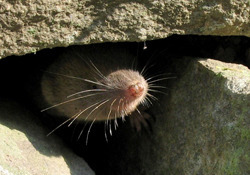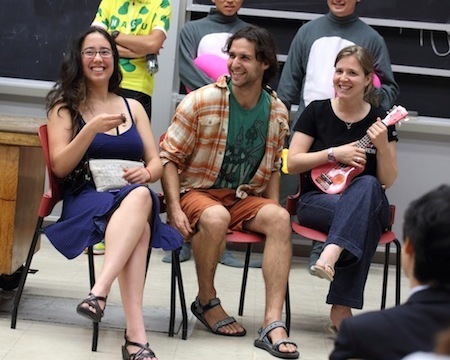Marc Abrahams's Blog, page 462
September 22, 2013
Dr. Karl, Ig Nobel winner, assesses a new generation
Dr. Karl Kruszelnicki, who was awarded an Ig Nobel Prize in 2002 for his discoveries about bellybutton lint, is not shy about expressing his opinion, on television, about some of the new Ig Nobel Prize winners:

Low notes, emanating from musical men
These videos document men singing remarkably low-pitched music. (Thanks to investigator Jim Cowdery for steering us to them.)
and also, if you need more, Neatorama’s “Singer Sets World Record for Lowest Vocal Note”

A Peek Inside the Ig Nobel Prize Selection Committee Process

Northern Short-tailed Shrew (blarina brevicauda) © 2007 by Gilles Gonthier
It’s unfortunate that the workings of the Ig Nobel Prize Selection Committee are off-limits to outside observers. Unfortunate but necessary, as adding observers (let alone cameras) would spoil the atmosphere, which can be funny, fascinating, and contentious.
But occasionally there is a story from the meetings that should be told.
The committee was assembled and was considering a particular nomination. Two of us thought that it might be too soon to award that research an Ig Nobel prize since it was so similar to the dead shrew paper. The room seemed a little confused, obviously not knowing what we meant by “The Dead Shrew Paper” and so we described how researchers had eaten a dead shrew, whole, and then carefully observed over the next several days what parts were lost during digestion; much more was lost during digestion than previously believed.
We described all this, watching the faces of our fellow committee members contort as they listened and understood.
As the reactions died down, Marc noted that we had never actually given this paper an Ig. My colleague and I were amazed: how had we never given THAT an Ig? We were both so completely convinced that it had gotten one – probably because it deserved one and because we have both been involved for enough years that it’s hard to keep track of all the near-misses.
Now that we knew it had never won, we were ready to push for it! We found the paper in the files and gave the room more details (again, enjoying the effect our descriptions were having).
Marc went around the room with this question, “if we give a prize to only one of these two papers, which would you choose?” The room went overwhelmingly for the dead shrew, and the other paper was moved to a list of strong candidates to be considered another year. The “Dead Shrew Paper” was moved to the list of strong contenders under consideration for 2013. About a month later, at the next meeting, it made the final cut

Northern Short-tailed Shrew (blarina brevicauda) © 2011 by Gilles Gonthier

Anna H. goes to the Ig Informal Lectures at MIT
Ever wonder what it’s like to be at the Ig Informal Lectures? Anna H, a member of the MIT class of 2014, went, and wrote about it, and posted some photos:
…This year, the Ig Nobel Prize official ceremony was held here in Cambridge – and, on Saturday September 14, all of the award recipients gave five-minute lectures (followed by a Q&A session) at MIT, in 26-100 (I sit through biology lecture in 26-100, three times a week!) It was impossible to pass up, so I went along, and brought my little sister. She was excited to be there!
In the opening moments, Marc Abrahams (the man behind the whole Ig Nobel thing) asked for a volunteer who had a watch.
I had a watch. My hand shot up first. (In my boyfriend’s words: “Classic Anna.”) Marc Abrahams’ eyes settled on me, and I got to take a seat on stage. Next, he asked for people who could make loud noises: one guy made a clicking sound with his tongue, and another woman pulled out her ukelele (unclear why she had it with her…this will remain one of life’s mysteries.) We made a good team:
(photo credit to “john carr aka vox sciurorum” on Flickr; the ukelele player e-mailed this picture to me)
I introduced myself to the other two, and found out that the man lives in Italy (I think it was Italy?) and the woman lives in the Netherlands: both are in Boston, traveling.
Our mission: to let the speakers know every time a minute passed, and to really let them know once their five minutes were up. Every minute, I cued the other two, who responded by making their noises…[read the entire essay, on the MIT Admissions blog]

September 21, 2013
Where/when nominative determinism got its name
Nominative determinism is always worth another look. Wikipedia gives a good overview of the concept. John Hoyland, creator and editor of the “Feedback” column in New Scientist magazine, coined the term. If you have come to Ig Nobel UK-tour shows in London and elsewhere in recent years, chances are good you saw Hoyland both explain both the history and give some freshly-found examples. Here’s a bit of Wikipedia‘s writeup (which in its full incarnation includes a long list of examples):
Nominative determinism refers to the theory that a person’s name is given an influential role in reflecting key attributes of their job, profession, or general life. It was a commonly held philosophy in the ancient world….
The term Nominative Determinism is a coinage of the Feedback column in the British popular science journal New Scientist, stemming from this item in 1994:
“WE recently came across a new book, Pole Positions – The Polar Regions and the Future of the Planet, by Daniel Snowman. Then, a couple of weeks later, we received a copy of London Under London – A Subterranean Guide, one of the authors of which is Richard Trench. So it was interesting to see Jen Hunt of the University of Manchester stating in the October issue of The Psychologist: “Authors gravitate to the area of research which fits their surname.” Hunt’s example is an article on incontinence in the British Journal of Urology (vol 49, pp 173-176, 1977) by J. W. Splatt and D. Weedon.[2] (This really does exist. We’ve checked it).”[3]
(Thanks to investigator Vaughn Tan for suggesting we revisit this splendid concept.)

September 20, 2013
Crap typo (fish)
Our Typo Evaluation Committee informs us that this is likely to be a typo:
On the effect of agricultural chemicals upon fish – I. Changes of chemical components in serum and liver of crap exposed to organophosphate compounds.
Sakaguchi, H
Bull. Jap. Soc. Sci. Fish. Vol. 38, no. 6, pp. 555-560. 1972.

‘Silly Walk’ studies (#2)
The Movement Lab at Ohio State University, US, is not the only academic institution to have experimentally evaluated ‘Silly Walks’ (see Part 1 of this series). On the other side of the Atlantic at the Department of Motion Science, University of Muenster, Germany, researchers Sook-Yee Chong, Heiko Wagner and Arne Wul have also performed a study.
“Seven healthy subjects were requested to perform silly walks, normal walking at self-selected speed (4.8 ± 0.5 km/h), 3.5 km/h, 4.0 km/h and 4.5 km/h on a treadmill.”
The team were interested in evaluating the role of Spinal Pattern Generators (SPGs) in normal and silly walk performance.
“We proposed that SPG in the spinal cord can interpret and respond accordingly to velocity-dependent afferent information. Changes in walking speed do not require a different motor control mechanism provided equilibrium is not affected and there is no disruption of the continuous rhythmic patterns produced at the ankle.”
The study ‘Application of neural oscillators to study the effects of walking speed on rhythmic activations at the ankle’ is published in Theoretical Biology and Medical Modelling, 2013, 10:9
A computer graphic representation of one of the silly walks is also provided : ‘One subject performing a silly walk’ (16.7MB in .avi format – which for convenience Improbable has transcoded into the smaller image above)
The team conclude that :
“We proposed that SPG in the spinal cord can interpret and respond accordingly to velocity-dependent afferent information. Changes in walking speed do not require a different motor control mechanism provided equilibrium is not affected and there is no disruption of the continuous rhythmic patterns produced at the ankle.“
And note opportunities for further studies.
“The movements performed by the subjects still involved an on-going, uninterrupted rhythmic pattern of activation between the antagonistic muscles at the ankle. Since we now know the same neural network is responsible for normal walking at different speeds, future studies can give the subjects a freer choice of the types of silly walks they would like to perform (like those seen in Monty Python’s sketch, The Ministry of Silly Walks). In such studies, significant differences in more model parameters might be found.”

September 19, 2013
When Carmen went to the Ig Nobel party
Carmen Nobel (yes, that is her name), the noted journalist, dropped by the Ig Nobel party, two nights after the 2013 ceremony. She wrote about it, on the Science Friday blog:
Small Talk with Scientists: The Ig Nobel Prize Winners Unwind
Perched near a long table full of crudité and tiny brownies at a Boston-area house party this past Saturday, South African entomologist Marcus Byrne is waxing poetic about dung beetles. “Dung is the opera of their life,” he says with authority.
Byrne and colleagues just won the 2013 Ig Nobel Prize in Biology and Astronomy for the recent study, “Dung Beetles Use the Milky Way for Orientation,” in which the researchers determined that “dung beetles transport their dung balls along straight paths under a starlit sky but lose this ability under overcast conditions.” (SciFri covered the research in this episode.)
The Ig Nobel Prizes, a loose spoof of the Nobel Prizes, honor 10 unusual scientific achievements that “first make people laugh, and then make them think,” says Marc Abrahams, editor of The Annals of Improbable Research. The staff of the science humor magazine has administered the prizes every fall since 1991.
Traditionally, after a campy, typically sold-out ceremony at Harvard’s Sanders Theatre and a lecture series at MIT, the participants attend an informal soirée a few nights later at the brownstone home of Jackie Baum (a former anthropologist) and Stanley Eigen (a math professor), friends of Abrahams’ who have been involved with the prizes since their inception. It’s a chance to relax and mingle with other people who understand what it’s like when people giggle at their life’s work….[read the entire essay]

September 18, 2013
Stammers Comments on Commentators, Questioningly
In the following publication, Stammers comments on commentators, questioningly:
Stanton, N.A. and Stammers, R.B. (2008) “Commenting on the commentators: what would Bartlett have made of the future past?” Ergonomics, 51, (1), 76-84.
Stammers is pictured here, standing and staring:

A biography of Tom Lehrer
If you are looking for a biography of Tom Lehrer — and why wouldn’t you be? — here’s one:
“Tom Lehrer: Having Fun,” Jeremy Bernstein, The American Scholar, 1984, vol.53, 3, pp.295-302.
Here are a few of the many good reasons why you might be looking:

Marc Abrahams's Blog
- Marc Abrahams's profile
- 14 followers







